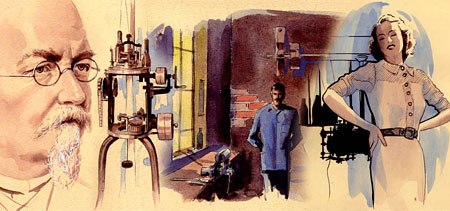Terrot History
With the foundation of the Terrot plants in 1862 Charles Terrot was laying the foundations
for a great idea that has lost none of its topicality.

1862
Together with the entrepreneur Wilhelm Stücklen, Charles Terrot founded the Terrot
plants. Working under extremely difficult technical conditions, he produced his
first circular knitting machines, which quickly conquered the market.
1871
The 500th Terrot machine for knitted underwear made of wool and cotton was awarded
with the silver wreath.
1887
The passing years saw the advent of a new generation with Charles’ two sons Ernst
and Franz Terrot as well as his son-in-law August Freund joining the business. The
company’s rapid development quickly led to further expansion of the high-performance
fast running double-sided loop plush, ajour patterns, lacework and striped fabrics.
1891
The first small-diameter circular knitting Department was founded in Bad Cannstatt.
The latest “American circular knitting machine for the automatic production of seamless
hosiery” was launched. These machines soon gained an international reputation and
were renowned for the reliability and precision which had already come to be associated
with name Terrot.
1903
After the death of Charles Terrot, the business continued to prosper in the hands
of his two sons Karl and Ernst, now trading under the name of C. Terrot Söhne.
1944
The advent of war took its toll on the company fortunes, reducing the Terrot factories
to a pile of rubble on the night of 20th October 1944 and destroyed the work of
three generations.
1946
With united effort, work began on rebuilding the Bad Cannstatt site. New production
halls were built for universal circular knitting machines, whose new patterning
possibilities opened up new markets the world over.
1955
World markets continued to be dominated by newly developed models such as the FR
and FMP, featuring what was the the very latest transfer device for underwear manufacture.
1968
The 1000th machine type FPM and FM left the factory in 1967. Outerwear fabrics could
be produced in line with market demand and with the fashion of the day using mechanical
jacquard needle selection. A short time later one of the first machines with film
band control for large pattern repeats was launched with the model RMA.
1973
The company’s leading position in terms of quality and output led to increased demand
for new machines to produce outerwear, such as the J3PN and J3P148.
1974
Fine machine gauges were launched to meet the demands of the fashion world for outerwear.
The I3P models in gauges E28 and E32 satisfied the demand of the new
1977
Terrot Strickmaschinen GmbH went on to demonstrate its experience and expertise
with a range of new developments over this period such as the type UMT and the high-performance
interlock machine I1108.
1982
A new 4-colour striper was developed to provide outstanding productivity and reliability
and proved a resounding market success in conjunction with the machine model S4F196.
1988
Take-over of the circular knitting machine manufacturer Sulzer Morat in Filderstadt
served to further reinforce the company’s market position, extending the product
range with electronically controlled circular knitting machines and special high
pile machines for imitation fur production.
1993
Following thr reunification of East and West Germany, the company took over the
former „Chemnitzer Strickmaschinenbau” knitting machine production. There followed
a heavy program of investment in buildings and machinery, bringing the plant in
line with the very latest technological standards.
1995
Takeover of the company Albi in Taiflingen. Three new machine models were added
to the product range: The models APL-E and APL-2 for jacquard and plain plush, and
the RFRM2 for bodywidth production with selvedge.
1996
Around 30 different large-diameter circular knitting machine models opened up new
fields of application for electronic and mechanical single and double jersey, for
modern outerwear and underwear, sport and leisurewear as well as technical textiles
and for the automotive sector.
1999
Terrot exhibited the first wide wind-up frame circular knitting machine to the international
public at the ITMA in Paris.
2002
As part of a fundamental organizational restructuring program, production and assembly
facilities were concentrated at the Chemnitz / Saxony location with capacity for
around 1000 machines a year. The company headquarters encompassing sales and marketing,
customer services, research & development and administration remained in Stuttgart
– Bad Cannstatt. The Terrot workforce numbers 350.
2004
Terrot develops the world’s first ultra-fine single jersey circular knitting machine
with a gauge of E46 and thus keeps the pace with rapidly changing market trends.
2006
Start-up of Terrot Textilmaschinen GmbH in Chemnitz. Terrot is under a new German ownership, managed
by Peter Schüring as the representative of the principal shareholder.
2007
With only one year as preparation time since the start-up, Terrot is already able
to show five innovations at the ITMA among those notably a mattress machine with
unreached productivity and flexibility.
2008
Mr. von Bismarck is appointed as further general manager. He already was in a managerial
capacity since the start-up of Terrot and affirms as the son of Mr. Peter Schüring
the authentic and long-time commitment of the new owners.
2010
Four years after the strategic reorientation of the company, Terrot achieved anew
a peak in order. The company expects an increase in sales of about 40% on the basis
of the last year’s turnover. Especially the fast growing demand from China, India,
Brazil, Turkey and East-Europe have had a remarkable impact on this boom.
2011
The worldwide most important leading trade fair ITMA was held from the 22nd – 29th
September 2011 in Barcelona, Spain. Terrot presented itself with six innovative
circular knitting machines out of the current product range and showed an excellent
selection of totally new and also further developed machines. The exhibited machines
chosen in the course of the fair corresponded in the best way to the present market
requirements and the current customer demands.
2012
Terrot celebrates its 150th anniversary!